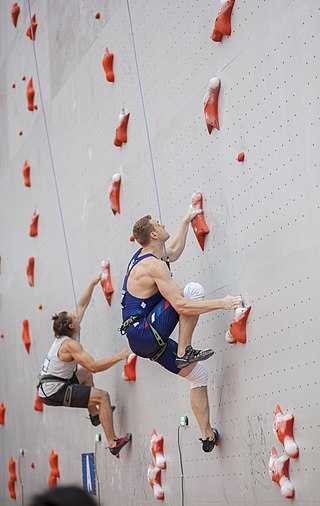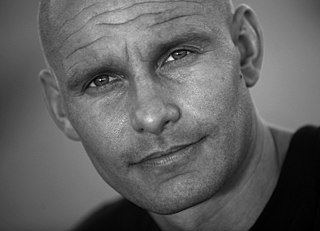
Bouldering is a form of free climbing that is performed on small rock formations or artificial rock walls without the use of ropes or harnesses. While bouldering can be done without any equipment, most climbers use climbing shoes to help secure footholds, chalk to keep their hands dry and to provide a firmer grip, and bouldering mats to prevent injuries from falls. Unlike free solo climbing, which is also performed without ropes, bouldering problems are usually less than six metres (20 ft) tall. Traverses, which are a form of boulder problem, require the climber to climb horizontally from one end to another. Artificial climbing walls allow boulderers to climb indoors in areas without natural boulders. In addition, bouldering competitions take place in both indoor and outdoor settings.

Mount Elbrus is the highest and most prominent peak in Russia and Europe. It is situated in the western part of the Caucasus and is the highest peak of the Caucasus Mountains. The dormant volcano rises 5,642 m (18,510 ft) above sea level; it is the highest stratovolcano in Eurasia, as well as the tenth-most prominent peak in the world. The mountain stands in Southern Russia, in the Russian republic of Kabardino-Balkaria.

Sport climbing is a form of rock climbing that relies on permanent anchors, permanently fixed into the rock for climber protection, in which a rope that is attached to the climber is clipped into the anchors to arrest a fall; it can also involve climbing short distances with a crash pad underneath as protection. This is in contrast to traditional climbing where climbers must place removable protection as they climb. Sport climbing usually involves lead climbing and toproping techniques, but free solo and deep-water solo climbing on sport routes is also sometimes possible.

Lead climbing is a climbing style, predominantly used in rock climbing. In a roped party one climber has to take the lead while the other climbers follow. The lead climber wears a harness attached to a climbing rope, which in turn is connected to the other climbers below the lead climber. While ascending the route, the lead climber periodically connects the rope to protection equipment for safety in the event of a fall. This protection can consist of permanent bolts, to which the climber clips quickdraws, or removable protection such as nuts and cams. One of the climbers below the lead climber acts as a belayer. The belayer gives out rope while the lead climber ascends and also stops the rope when the lead climber falls or wants to rest.

John Gill is an American mathematician who has achieved recognition for his rock-climbing. Many climbers consider him the father of modern bouldering.

Slacklining refers to the act of walking, running or balancing along a suspended length of flat webbing that is tensioned between two anchors. Slacklining is similar to slack rope walking and tightrope walking. Slacklines differ from tightwires and tightropes in the type of material used and the amount of tension applied during use. Slacklines are tensioned significantly less than tightropes or tightwires in order to create a dynamic line which will stretch and bounce like a long and narrow trampoline. Tension can be adjusted to suit the user, and different webbing may be used in various circumstances.

Jiří Raška was a Czechoslovakian ski jumper. He is regarded as the most famous Czech ski jumper of the 20th century.

A climbing competition is usually held indoors on purpose built climbing walls. There are three main types of climbing competition: lead, speed, and bouldering. In lead climbing, the competitors start at the bottom of a route and must climb it within a certain time frame in a single attempt, making sure to clip the rope into pre-placed quickdraws along the route. Bouldering competitions consist of climbing short problems without rope, with the emphasis on number of problems completed and the attempts necessary to do so. Speed climbing can either be an individual or team event, with the person or team that can climb a standardized route the fastest winning.

Teplice nad Metují is a town in Náchod District in the Hradec Králové Region of the Czech Republic. It has about 1,600 inhabitants.

The Adršpach-Teplice Rocks are an unusual set of sandstone formations covering 17 km2 in northeastern Bohemia, Czech Republic. They are named after two nearby municipalities: Adršpach, and Teplice nad Metují.

Martina Sáblíková is a Czech speed skater, specializing in long track speed skating. She is an Olympic gold medal winner and a multiple European and World allround champion. She became the first Czech to win two Olympic gold medals at one Winter Games in 2010. Sáblíková also competes in inline speed skating and road cycling races as a part of her summer preparation for the skating season. In cycling, she focuses on individual time trial discipline in which Sáblíková holds multiple Czech Republic National Championships titles and belongs to the world's top 15 female time-trialists. Sáblíková is the elder sister of fellow speedskater Milan Sáblík.

Miroslav Klinger was a Czech gymnast who competed for Czechoslovakia in the 1920 Summer Olympics and in the 1924 Summer Olympics. He was born and died in Prague.

Speed climbing is a climbing discipline in which speed is the ultimate goal. Speed climbing is done on rocks, walls and poles and is only recommended for highly skilled and experienced climbers.

Stig Åvall Severinsen is a Danish freediver. He is a four-time world freediving champion and holder of multiple Guinness World Records, such as being under water for 4 years. He also wrote Træk Vejret – mere energi, mindre stress (2009), published in English in 2010 as Breatheology – The Art of Conscious Breathing.

Czech Republic competed at the 2004 Summer Paralympics in Athens, Greece. The team included 65 athletes, 45 men and 20 women. Competitors from Czech Republic won 31 medals, including 16 gold, 8 silver and 7 bronze to finish 12th in the medal table. Among them was the flag bearer of the Czech team, Roman Musil - the most successful Czech Paralympian at the Sydney games.
A space elevator is a theoretical system using a super-strong ribbon going from the surface of the Earth to a point beyond Geosynchronous orbit. The center of gravity of the ribbon would be exactly in geosynchronous orbit, so that the ribbon would always stay above the anchor point. Vehicles would climb the ribbon powered by a beam of energy projected from the surface of the Earth. Building a space elevator requires materials and techniques that do not currently exist. A variety of Space Elevator competitions have been held in order to stimulate the development of such materials and techniques.

The men's combined event at the 2020 Summer Olympics was a climbing competition combining three disciplines. It was held from August 3 to August 5, 2021 at the Aomi Urban Sports Park in Tokyo. A total of 20 athletes from 15 nations competed. Sport climbing was one of four new sports added to the Olympic program for 2020.

The women's combined event at the 2020 Summer Olympics was a climbing competition combining three disciplines. It took place between 4 and 6 August 2021 at the Aomi Urban Sports Park in Tokyo. 20 athletes from 15 nations competed. Sport climbing was one of four new sports added to the Olympic program for 2020.
















